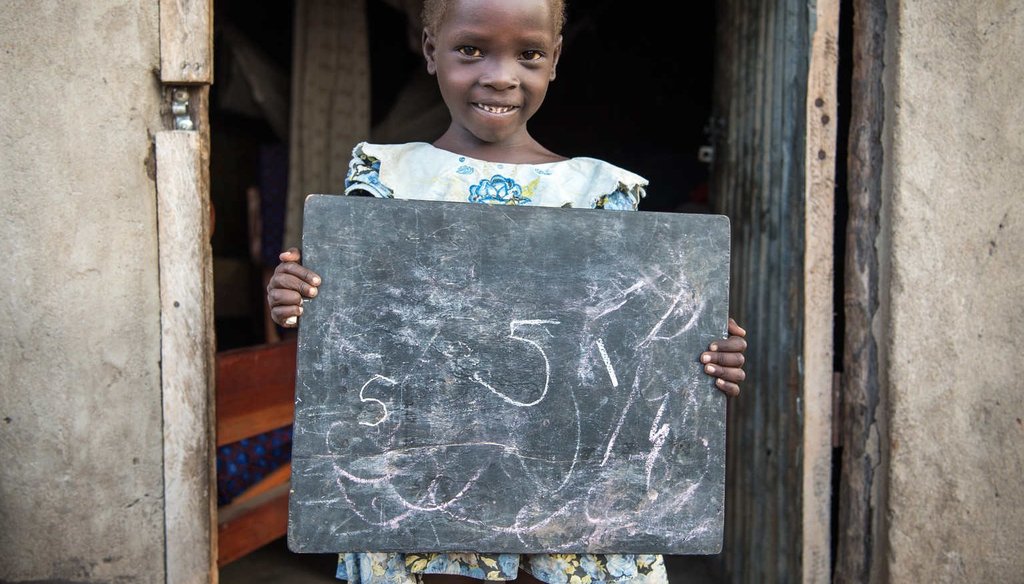

Our only agenda is to publish the truth so you can be an informed participant in democracy.
We need your help.


Susan Andua, 5, outside her mother Florence’s house in Nimule, South Sudan.(UNICEF/UNI203956/Everett)
There are countries where the measures of well-being tell such a bleak story, you have to stop and verify them. South Sudan falls in that group.
UNICEF, the United Nations International Children’s Emergency Fund, marked the fifth year since this African nation separated from its northern neighbor with a photo essay about five children. One showed a little girl shyly smiling as she holds an oversized slate chalkboard bearing two perfectly legible number 5s.
The caption read, "Only about 10 percent of girls in South Sudan complete primary school, and the typical age of marriage in rural areas is rarely over 15. As a result, more teenage girls die in childbirth than finish high school."
South Sudan emerged as an independent country in 2011 after years of civil war. Its people barely had time to catch their collective breath before friction between two rival factions turned the country back into a battlefield again. The fighting has forced millions from their homes.
Under these conditions, it’s plausible that more teenage girls dying in childbirth than graduate from high school, but every claim needs data behind it, and we went looking.
Girls in South Sudan who finish high school
Ongoing conflict has made education nearly impossible. A 2014 Brookings Institution article noted that "approximately 50 percent of primary school-age children are currently not in school."
So how many girls finish high school? We can’t say for certain, but we know the number is quite low.
The South Sudanese government reported that in 2013, just 730 girls were in the last year of secondary school out of a total population over 12 million.
Girls in South Sudan who die in childbirth
Finding a precise number of teenage girls in South Sudan who die during childbirth is more complicated because accurate data in a war zone is hard to come by.
To get even a crude estimate, we had to rely on a couple of figures.
First a 2008 survey of South Sudan found that about 10.3 percent of all women in the country were 15-19. That translates to about 610,000 teenage girls.
A 2010 government health survey said that "in South Sudan, one-third of the 15-19 year old women start childbearing." That would mean about 207,000 young women are at risk of dying in childbirth.
Based on UNICEF data, the nonprofit aid group International Medical Corps wrote that "with 2,054 maternal deaths per 100,000 live births, South Sudan has the highest maternal mortality rate in the world."
When we apply that rate to the number of young women at risk, we get over 4,000 deaths. That’s nearly six times the maximum number of female high school graduates.
What experts say
People and groups with on-the-ground experience in South Sudan said they have no reason to doubt UNICEF’s comparison.
Lydia Stone, now with the British aid organization Social Development Direct, told us that "while there is a dearth of reliable, recent data in South Sudan, this UNICEF claim is almost certainly true." Stone said that most girls "are married around the age of 15-16 some even younger. Their bodies are not ready to bear children and - outside of aid agencies - the health system is virtually non-existent."
Canada is a major donor of relief services in South Sudan. Global Affairs Department spokeswoman Jessica Seguin said "South Sudanese girls’ face significant inequalities in terms of access to education, and are at a high risk of early and forced child marriage, and accompanying obstetric health problems."
In a 2012 field report, Stone wrote that the society puts a premium on women having as many children as possible. During the first civil war, government leaders cast pregnancy as a patriotic duty. But Stone wrote that in interviews, many women embraced their role quite apart from any overt pressure.
"One woman said, ‘There is no limit; if I can have 15 or 20, then I will. It is for God to decide.’"
Our ruling
UNICEF wrote that in South Sudan, "more teenage girls die in childbirth than finish high school."
The claim is almost certainly correct, experts say. But there is no single data source that can verify the comparison.
We rate this claim Mostly True.
Medium, Turning five with South Sudan, July 6, 2016
Government of the Republic of South Sudan, Education statistics: 2013, 2014
Republic of South Sudan, National Bureau of Statistics, accessed July 17, 2016
CIA World Factbook, South Sudan, accessed July 17, 2016
Republic of South Sudan, Southern Sudan Household Health Survey 2010, 2011
World Bank, South Sudan: 2015, accessed July 17, 2016
International Medical Corps, South Sudan: Maternal & Child Health, accessed July 12, 2016
Small Arms Survey, Threats in the home, January 2012
Georgetown Institute for Women, Peace and Security, Security, Basic Services and Economic Opportunity in South Sudan, July 2014
Brookings Institution, South Sudan’s Road to Peace: High Stakes for Its Children, Feb. 3, 2014
News Deeply, Life and Death: Delivering Babies in South Sudan, June 30, 2016
World Health Organization, South Sudan: Country cooperation strategy, April 2014
IRIN, The biggest threat to a woman's life, July 20, 2012
United Nations Development Program, South Sudan human development report, 2015
Email interview, Lydia Stone, lead consultant, Social Development Direct, July 13, 2016
Email interview, Jessica Seguin, spokeswoman, Global Affairs, Government of Canada, July 14, 2016
In a world of wild talk and fake news, help us stand up for the facts.
